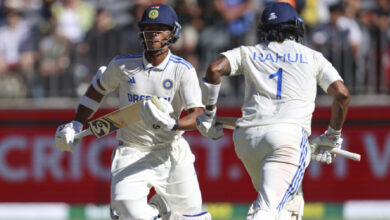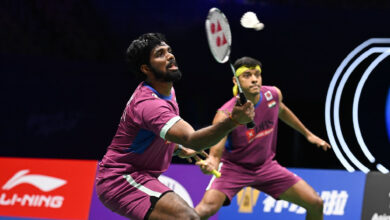Pravin Thipsay writes: After an exciting draw in the final game, Nepo will have the edge in tie-breaker

A tie after 14 exciting, high-octane games of the World Chess Championship is perhaps the right result. Would it have been a sour victory had Ding Liren won the final game and the match? Playing with white pieces, he had the advantage but Nepo was prepared. With a draw in 90 moves, it was easily the most exciting match of this Championship.
The icing on the cake now is that we’re in for a Super Sunday! Tie-breakers are going to be fun if Game 14 was any indication of what’s going to come. It was remarkable the way Ding played for a win on Saturday. He’s very clear about the way he wants to play, and that’s to attack. It’s really in the true spirit of the sport. We’re seeing such vigorous play after several decades. (Grandmaster Pravin Thipsay has been analysing games of the World Chess Championship for The Indian Express. You can read his analysis of Game 13, Game 12, Game 11, Game 10, Game 9, Game 8, Game 7, Game 6, Game 5, Game 4, Game 3, Game 2, and Game 1.)
Nepo replied to Ding’s Queen Pawn opening with Nimzo Indian Defence but Ding chose a rarely played choice on move 5, a move he had chosen against Praggnanadhaa successfully last year. However, Nepo decided to vary on move 7 with a central Pawn break. On move 9, Ding made an extremely rare move invented Donchenko and but clearly, Nepo was well prepared for it. With a novelty on move 10, a logical Pawn exchange in the centre, Nepo had little difficulty in equalising.
Instead of choosing a strategic path with a Pawn advance in the centre, Ding initiated a rash attack against Nepo’s King on move 12 and offered a Knight on move 13. Nepo correctly refrained from capturing the Knight and concentrated on safeguarding his position. On move 15, it became clear that the attack didn’t have much steam, so Ding exchanged Queens to reach a drawish ending on move 18. In order to create some complications, Ding offered a Bishop exchange on move 19, a dubious decision that made some winning chances only for the opponent!
On move 9, Ding made an extremely rare move invented Donchenko and but clearly, Nepo was well prepared for it. On move 9, Ding made an extremely rare move invented Donchenko and but clearly, Nepo was well prepared for it. (FIDE/ Anna Shtourman)
Though Nepo had an upper hand in the ending, Ding succeeded in creating some complications and vague threats.
Nepo guarded against the threats successfully and move 36, he seemed to be all set to win the World Crown. activating his Rook further on move 36, the Russian could have retained his advantage but his safe Pawn move gave Ding enough time to organise a successful defence.
With a brilliant Pawn sacrifice on move 18, despite severe time trouble, Ding forced a theoretically drawn Rook Ending. Nepo tried his best to make use of his extra Pawn but Ding defended very accurately and the game was eventually drawn after 90 moves.
The players indeed played superb Chess from move 38, without a single inaccurate move. And that’s really something. Nepo did press hard for the last 50 moves but the Russian Proverb “All Rook endings are drawn!” turned out to be very correct in the game.
It’s going to be a tough Sunday for the players and the one who shows more vigour, energy and better presence of mind will emerge as the new world Champion.
Tie-breakers are all about playing quickly and we’ve seen the kind of trouble Ding has gotten into. It’s almost 1/4th of the time the players have been consuming now. For me, that really puts the pressure on the Chinese Grandmaster.
It certainly feels that in terms of strategy, Nepo has been great with his preparation. He’s very clear with his strategy and when since they now have just 25 minutes each for a game, it certainly gives him the edge.
It should be decided in the first tie-break itself which will have four Rapid games with time control of 25 Min plus an increment of 10 seconds after every move.
(Pravin Thipsay is an Indian Grandmaster and a recipient of the Arjuna Award)
Moves (Game 14): 1.d4 Nf6 2.c4 e6 3.Nc3 Bb4 4.e3 0–0 5.Bd2 d5 6.a3 Be7 7.Nf3 c5 8.dxc5 Bxc5 9.Qc2 dxc4 10.Bxc4 Nbd7 11.Rd1 Be7 12.Ng5 h6 13.h4 Qc7 14.Be2 Rd8 15.Rc1 Nf8 16.Nge4 Nxe4 17.Nxe4 Qxc2 18.Rxc2 Bd7 19.Bb4 Bxb4+ 20.axb4 Bc6 21.Nc5 Bxg2 22.Rg1 Bd5 23.e4 Bc6 24.b5 Be8 25.Nxb7 Rd4 26.Rc4 Rd7 27.Nc5 Rc7 28.Rc3 Rac8 29.b4 Nd7 30.Rcg3 Nxc5 31.bxc5 Rxc5 32.Rxg7+ Kf8 33.Bd3 Rd8 34.Ke2 Rc3 35.Rg8+ Ke7 36.R1g3 e5? 37.Rh8! Rd6 38.b6!! Rxb6 39.Rxe8+! Kxe8 40.Bb5+! Rxb5 41.Rxc3 Kd7 42.Rf3 Ke7 43.Rc3 a5 44.Rc7+Kf6 45.Rc6+ Kg7 46.Ra6 Rb2+ 47.Kf3 Ra2 48.Kg3 h5 49.Ra8 Ra1 50.Kg2 a4 51.Ra5! f6 52.Kf3 a3 53.Ra6 Kf7 54.Ke3 Ke8 55.Ke2 Ke7 56.Kf3 Ra2 57.Ke3 Ra1 58.Ke2 Kf7 59.Kf3 Ra2 60.Ke3 Ke7 61.Kf3 Kd7 62.Rxf6 Rb2 63.Ra6 Rb3+ 64.Kg2 Kc7 65.f4!! [Only move to draw.] 65…exf4 66.e5! Kb7 67.Ra4 Kc6 68.Ra6+ Kb5 69.Ra7 Kb6 70.Ra8 Kc5 71.Ra6 Kb5 72.Ra7 Kb6 73.Ra8Kc6 74.Ra6+ Kd7 75.Kf2 Ke7 76.Kg2 Re3 77.Kf2 Rg3 78.Kf1 Rc3 79.Kf2 Re3 80.Kg2 Kd7 81.Kf2 Kc7 82.e6 Kd8 83.Ra7 Ke8 84.Kg2 Rxe6 85.Rxa3 Rg6+ 86.Kf2 Rg4 87.Ra5! Rxh4 88.Kf3 Ke7 89.Rf5 Ke6 90.Rxf4 Rxf4+ Game drawn agreement.







